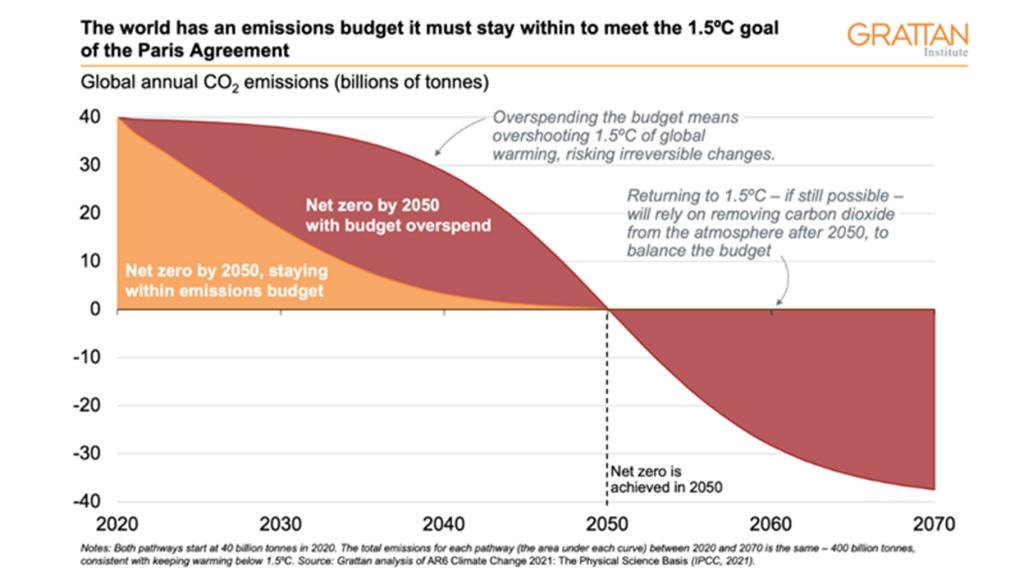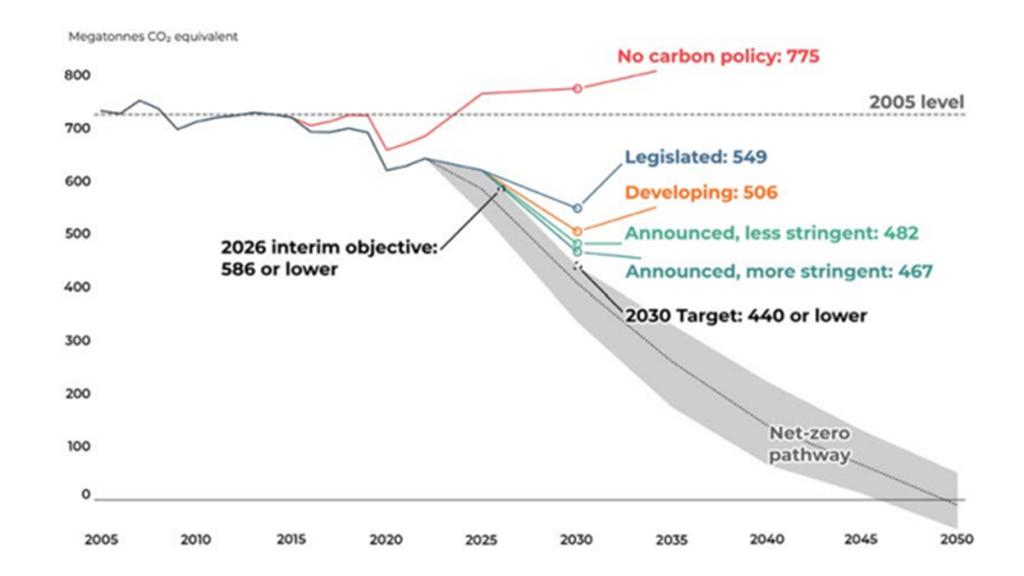The Critical Next Step: What you need to know about Canada’s 2030 climate target
At the close of 2023, Environment and Climate Change Canada released the first official Progress Report on its 2022 Emissions Reduction Plan. The report details progress toward the government’s 2030 climate goals as mandated by the Net Zero Accountability Act, forecasting that, if all modelled policies are fully implemented, national emissions will fall to 36% below 2005 levels in 2030. A parallel, independent assessment by the Canadian Climate Institute (CCI) mirrors these findings, forecasting a 34%–36% reduction. While these reports confirm that progress has been made in recent years to reduce Canada’s emissions, they also show that current measures are insufficient to reach the government’s 40%–45% reduction target. To close this gap and help avoid the worst impacts of climate change, it is essential that the federal government implements stronger policies alongside a clearer communications strategy.
What are Canada’s climate targets?
Federally, Canada has two complementary climate targets. The first is achieving “net-zero by 2050,” meaning that any new greenhouse gas emissions from 2050 onwards are offset by verifiable and permanent removals. To prevent the most dangerous effects of climate change, this is a necessary target for all countries, not just Canada. The federal government’s second climate target is to reduce national greenhouse gas emissions by 40% to 45% relative to 2005 levels by 2030.
Provincially, most governments echo the federal goal of “net-zero by 2050,” but 2030 targets are still rare. According to CCI, “three quarters of Canada’s emissions come from provinces and territories without their own legislated emissions reduction targets for 2030.” This discrepancy reflects a tension between the two levels of government regarding the pace of the energy transition, as articulated in the recent statements of Alberta’s premier about the forthcoming Federal Clean Electricity Regulations. That is, Premier Smith notes Alberta already has a target of reaching net-zero by 2050, so why bother with stringent 2030 regulations?
Why Canada’s 2030 target is critical for keeping global temperature rise to 1.5°C
Canada’s 2030 target is essential for maintaining a stable climate for two main reasons. The first is scientific. When the International Panel on Climate Change recommended the world reach net-zero by 2050, it simultaneously called for emissions to fall by 45% (relative to 2010) by 2030. What matters for the climate is not the specific year the world stops emitting greenhouse gases but rather the amount of greenhouse gases in the atmosphere. Figure 1, where total emissions are represented by the area under the line, makes this clear. Even if the world achieves net-zero by 2050, without strong emissions reductions by 2030 it becomes very difficult to prevent more than 1.5°C of global warming. In other words, reaching net-zero by 2050 without taking 2030 targets seriously risks missing the 1.5°C temperature target with disastrous consequences worldwide—including billions of dollars in damage to the Canadian economy.

The second reason for a strong 2030 emissions target is political. By establishing a specific and measurable goal, it becomes easier to assess the government’s progress in addressing climate change. This creates an incentive for politicians to fulfill their commitments to the public. The risk with a “net-zero by 2050” target on its own, however, is that political tenures and election cycles are short. Multi-decadal targets like this offer a convenient delay tactic for politicians who are otherwise unmotivated to address climate change. A 2030 target is essential to keep governments on track for net-zero by 2050, and ultimately that 1.5°C temperature target, by holding our representatives accountable along the way.
What more can be done to meet Canada’s targets?
The government’s progress report shows that despite significant advances in climate policy, more must be done to meet Canada’s critical 2030 targets (Figure 2). To start, announced but unimplemented policies must be designed as stringently as possible. A key example here is the proposed emissions cap for the oil and gas sector, Canada’s most polluting industry. To reach a 40%–45% reduction in emissions by 2030, the government must begin by closing the policy’s proposed loopholes, thereby increasing certainty in the emissions reduction outcomes that the government claims the policy will have. Other policies, such as the clean electricity regulations, must also be implemented as soon as possible. Even then, however, new, innovative policies will still be needed. There are only 6 years to 2030, and there is a lot of work left to do.

Beyond policy development, there is a broader communications challenge facing the federal government. Opponents of climate policy have often tried to link specific measures to the cost-of-living challenges currently facing Canadians, particularly criticizing the carbon tax. This is in spite of the fact that most households benefit from the tax and rebate system. Some provincial governments, meanwhile, show no intention of setting or meeting 2030 targets, while also disputing the federal government’s authority to intervene in response to their inaction. While it is correct that provinces have jurisdiction over natural resources, the federal government can regulate matters of national concern—such as greenhouse gas emissions—in a way that incidentally affects provincial matters. Opposing legal challenges are thus overstated, but they nonetheless carry weight in public discourse. To build the public support necessary to accelerate Canada’s climate agenda, the government will have to do more to address these rhetorical and legal challenges head-on—confidently and publicly.
You might also be interested in
Ottawa supports Big Oil over the climate
One can only imagine the positive buzz these days inside the boardrooms of Canada's oil companies, as they rake in record profits and plan major expansions of their oil production. Amid all the good cheer, one could easily lose sight of the fact that those plans will push the world dangerously closer to the brink of irreversible climate chaos. Even as the world finally signed a commitment at UN climate talks last month to begin transitioning away from fossil fuels, Canada's major oil companies are poised to do exactly the opposite — to greatly expand their fossil fuel production.
Feds and province veto offshore oil exploration in Nova Scotia
A licence to explore the offshore of Nova Scotia for oil and gas and restart fossil fuel activity there after years of dormancy was rejected Monday by the federal and provincial governments. The decision to reject the licence considers broader policy focused on "shared commitments to advance clean energy and pursue economic opportunities in the clean energy sector, which are beyond the scope of the board's regulatory purview," a joint statement said.
IISD: EU’s historic Energy Charter Treaty vote will boost energy transition
The European Parliament has voted for the European Union to withdraw from the climate-threatening Energy Charter Treaty.
Blackouts and Backsliding: Energy subsidies in South Africa 2023
Blackouts and Backsliding presents the latest energy subsidy data for South Africa.
